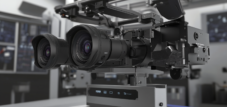Published on: March 30, 2025 / update from: March 30, 2025 - Author: Konrad Wolfenstein

VR glasses Pimax Crystal Super: A deep analysis of the high-end-VR head set-Image: Pimax / Xpert.digital
High-end VR with Pimax Crystal Super: A new scale?
Pimax Crystal Super in comparison: outstanding or overvalued?
The Pimax Crystal Super enters the stage of Virtual Reality (VR) as a high-resolution, PC-based VR headset that claims to offer a visual experience of the extra class. With interchangeable optical modules, an impressive resolution and a wide field of vision, it aims to address VR enthusiasts and professional users alike. But how does this ambitious device do in the hard competition of the VR market?
Suitable for:
The promise of clarity and immersion
The heart of the Pimax Crystal Super is the endeavor to incomparable visual clarity. With a resolution of 3840 × 3840 pixels per eye (or 3840 × 3552 in the micro-oled variant), it clearly exceeds many competitive products. This high pixel density, coupled with a wide range of views of up to 135 degrees, is intended to immerse the user deeper into the virtual world than ever before.
But the Crystal Super is more than just raw pixel power. It offers a variety of display options, including QLED panels with mini-LED backlight and local dimming as well as micro-oled displays for more sowing black tones and a higher contrast. In addition, there is eye-tracking with foveated rendering, which reduces the computing load by only portraying the area that the user is looking at.
A declaration of war on the competition
With these impressive specifications, the Pimax Crystal Super positions itself as a high-end-VR headset that is specially tailored to the needs of VR enthusiasts, SIM racers and professional users. It is the latest flagship of Pimax's “Crystal” product line and exceeds the Crystal Light in terms of functions and performance.
Compared to the original Crystal, the great improvements in areas such as eye tracking, IPD adjustment and display options offer. But it's not just an incremental upgrade. With the Crystal Super, Pimax seems to want to set a new standard for visual quality and immersion in the VR.
Technical details in detail
In order to really understand the potential of the Pimax Crystal Super, a closer look at the technical specifications is essential:
resolution
3840 x 3840 pixels per eye (QLED) / 3840 x 3552 pixels per eye (micro-oled)
Corporation frequency
72 Hz-90 Hz (QLED, up to 120 Hz possible), 72 Hz-90 Hz (Micro-Oled)
Display technology
QLED with mini-LED backlight and local dimming, micro-oled
Viewing field (FOV)
120 ° horizontal (QLED 57 ppd), 135 ° horizontal (QLED 50 ppd), 102 ° horizontal (micro-oled)
Pixeld density (PPD)
57 PPD / 50 PPD (QLED), advertised as a “retina level” clarity
Lentils
Glass aspach lenses (QLED), Pancake lenses (micro-oled)
Tracking
Inside-out tracking with integrated cameras, optional Lighthouse facial plate
Eye tracking
200 Hz Corporation Retonal Frequency, Dynamic Foveated Rendering 2.0, automatic IPD adjustment (58-72 mm)
Audio
Exchange 3.5 mm audiobook, two built-in microphones, compatible with DMAS
Controller
Included two controllers included
Connectivity
DisplayPort (DP)
Miscellaneous
No wireless streaming, pure PCVR headset, reduced size and weight compared to the crystal
The meaning of the details
The high resolution and refresh rate require a powerful PC configuration, ideally with an NVIDIA RTX 3080 or better. The modular design with interchangeable optical modules enables the user to optimize the headset for various applications. For example, you can choose between a wider field of vision and a higher pixel density.
Integrated eye tracking is not only useful for automatic IPD adjustment, but also enables Dynamic Foveated Rendering. This reduces the computing load of the graphics card, since only the area is shown sharply to which the user is looking at. This can lead to a higher frame rate and a fluid VR experience.
Critical voices: What do the experts say?
The first impressions of the Pimax Crystal Super were promising. The sharpness and clarity of the picture were praised as well as the high brightness values that the headset could make one of the brightest on the market. Comfort is also said to have been improved compared to previous Pimax models.
However, there were also criticisms. In pre-series models, Mura effects (unevenness in the screen) and “tiger strips” (vertical lines) were found. In addition, distortions and a “pupil swim” effect were observed, in which the geometry of objects changes during head movements.
Some reviewers expressed concerns whether Pimax can fix these problems in good time. The past has shown that the company had difficulty complying with its promises and delivering consistently high quality. The price of around $ 2,000 was also perceived by some.
The dilemma of high expectations
The use of high -resolution and very bright displays can increase problems such as Mura. This requires careful calibration and quality control in production. The success of the Crystal Super depends on whether Pimax can refine the hardware and software before the final publication in order to fix the reported problems and justify the premium price.
The repeated mention of previous problems with Pimax products and their software indicates a lack of trust within the VR community. This has to overcome Pimax to successfully establish the Crystal on the market.
Suitable for:
Comparison with the competition: Who is ahead?
In order to be able to better classify the Pimax Crystal, a comparison with other high-end VR headsets is essential:
Varjo aero
Similarities related to resolution, eye tracking and automatic IPD adjustment. However, the Crystal Super offers a higher resolution and a wider field of vision. However, the Varjo Aero is more comfortable and offers more mature software.
Valve Index
The Crystal Super clearly exceeds the Valve Index in terms of resolution and field of vision. However, the index scores with a higher refresh rate, an excellent integrated audio system and higher wearing comfort. In addition, the index is usually cheaper.
Meta Quest 3
The Crystal Super offers a higher resolution than the Meta Quest 3. However, the Quest 3 is an independent headset and significantly cheaper. The Crystal Super, on the other hand, is dependent on a PC.
Suitable for:
- Samsung Android XR-Headset Project Moohan Premiere at the Mobile World Congress (MWC) 2025 in Barcelona
The agony of choice
The choice between these headsets depends heavily on the budget, the priorities (visuals, comfort, tracking type, standalone ability) and the tolerance towards potential software and hardware owners. The Pimax Crystal Super is undoubtedly a top product in terms of visual specifications. However, there is compromises in terms of price, comfort and software ecosystem.
What does the community say?
The VR community shows a cautious interest in the Pimax Crystal Super. The high pixel density and the potential visual clarity are praised. However, there are significant concerns due to the problems of PIMAX with software, processing quality, compliance with delivery dates and customer support.
Many users express their disappointment that the Lighthouse facial plate is not immediately available for the super. Others question whether the price increase compared to the Crystal Light justifies incremental improvements.
Pimax on the crossroads
Overall, there is a strong interest in a headset with the specifications of the Crystal Super in the VR community. Pimax, however, has to overcome his reputation for non -observed promises and problems with quality control in order to gain broad trust and acceptance.
Negative experiences with previous Pimax products influence the expectations of the users and the degree of skepticism compared to new publications. Pimax has to prioritize software stability, fix hardware errors that were reported in early units and offer reliable customer support in order to be super successful with the Crystal.
Pricing and availability: a complicated topic
The pricing of the Pimax Crystal Super is unconventional. The base price is $ 999 as an advance payment for the headset. However, a “Pimax Prime” membership is required for complete possessions, which includes monthly payments or a one-off payment after a test phase.
The total price for the Crystal Super QLED 57PPD is between 1696 and $ 1791. The monthly payment option is $ 32.99 for 24 months, and the one-off payment after the test phase is $ 696 or $ 697.
A subscription for VR?
This pricing model could be confusing for consumers who are used to traditional unique purchases. The lower purchase price could attract some buyers, but the long -term costs with the subscription must be carefully weighed.
Pimax delivers to the European Union. The shipping costs and taxes are calculated at the cash register. Potential buyers should take shipping costs, import duties and the fluctuating USD-UR change course into account.
The ecosystem: accessories and extensions
Pimax offers a number of accessories for the Crystal Super, including the Micro-Oled Optical Engine, DMAS headphones, Comfort Topstrap and Facial Foam Kit. A 6M over Optical Cable and a hand tracking modules are also available.
Third -party providers such as StudioForm Creative and Hans VR also offer accessories that could be super compatible with the Crystal. Potential buyers should take the costs for additional accessories into account when evaluating the overall investment in the Pimax Crystal Super E-Ecosystem.
The agony of choice: which version is the right one?
There are three main variants of the Pimax Crystal Super:
50 PPD QLED
Offers a wider field of vision (135 °) and is ideal for users who prefer an immersive experience.
57 PPD QLED
Offers a higher pixel density (57 ppd) and is ideal for users who are looking for maximum visual clarity.
The choice of the right version depends on the individual preferences. Users who appreciate a broader immersive experience could prefer the 50 PPD QLED version, while those who are looking for maximum clarity that could choose 57 PPD QLED or the micro-OLED version.
Potential with question marks
The Pimax Crystal Super offers impressive strengths such as a high resolution, a wide range of vision, various display options and eye tracking. The weaknesses include the unconventional price model, the potential for technical problems and the company's previous reputation.
For enthusiasts who are looking for first -class visual experience, the Crystal offers super impressive specifications. However, it requires a powerful PC and the willingness to fix possibly occurring problems. Users who have concerns about Pimax's previous performance should exercise caution and wait for independent tests of the final sales versions before making a purchase decision.
The Pimax Crystal Super represents a significant progress in terms of display technology for VR. However, its ultimate success will depend on factors that go beyond pure specifications, including reliability, user experience and price-performance ratio. It remains to be seen whether Pimax can exploit this potential.
Suitable for:
Your global marketing and business development partner
☑️ Our business language is English or German
☑️ NEW: Correspondence in your national language!
I would be happy to serve you and my team as a personal advisor.
You can contact me by filling out the contact form or simply call me on +49 89 89 674 804 (Munich) . My email address is: wolfenstein ∂ xpert.digital
I'm looking forward to our joint project.














